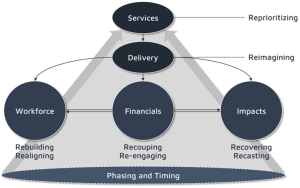8
Much has changed for non-profits as they’ve adapted to Covid-19. As previously discussed, organizations have had to respond to the conditions, re-prioritizing and modifying programs and delivery to match demand. They’ve adapted the workforce, communicated changes, engaged key connections, and prepared themselves for uncertainties.
At some point (hopefully soon!) Covid-19 will be just a memory, and non-profits can get back to “normal.” Even now, as states “re-open,” some non-profits are starting to increase on-site services, re-engage volunteers, and get employees back into the office. There is some “awakening” but, for many organizations, it will be a long process.
Getting back to normal shouldn’t mean going back in time, simply returning to prior services, delivery methods, and ways of doing business. For one thing, demand will lag as the economy recovers. And, much has been learned from alterations non-profits have made. For many non-profits, there is opportunity to be better by integrating changes!

The awakening is more than just “turning the lights back on). There are a number of factors non-profits need to consider as they emerge from Covid-19, summarized in Figure 14 (below). They are interconnected, and driven by demand, conditions, outcomes from operations during Covid-19, and positioning for the future.
As with other considerations discussed in this document, organizations can’t just “wing it” and hope for the best. Many are asking, however, whether it is possible to plan ahead—let alone be strategic about it—when there is so much uncertainty about the future. It isn’t just possible—sound strategy always requires flexibility—it’s essential.
Figure 14—Factors to consider in emerging from Covid-19

The framework above deserves more discussion around its different elements, since the brief descriptions hide many important details. For example:
- Services—Many non-profits modified programs in response to Covid-19 (see Section 3), re-defining and re-prioritizing based on demand. They will need to re-adjust, but need to be sensitive to realities on the ground. Demand shifts are likely to lag behind economic and other aspects of recovery.
- Delivery—Delivery methods may also have been adjusted, and non-profits shouldn’t look backwards. Clients may like—even prefer—new access points. and they may be more cost-effective. Evaluating changes is important, and non-profits should think ahead to find the best approaches for the future.
- Workforce—Staff and volunteers may return to a new world requiring different responsibilities and skills. This may mean reconfiguring staffing, and re- or cross-training people.[1] It also makes sense for organizations to evaluate how remote models worked—they may be more cost-effective too![2]
- Financials—Some non-profits will be in a better position than when the pandemic started! While labor costs may increase, those that have gained efficiencies from operational changes, embraced remote workforce models, and/or strengthened donor relations,See Section 7. Non-profits can develop stronger relationships with their donors (and have lessons learned from outreach efforts), which will benefit them as they emerge from Covid-19. Simultaneously, an improved economy will open new doors with both old and new donors. there may be long-term net gain.
- Impacts—Some non-profits will have permanent changes in focus (e.g., new or modified programs), and will need to recast themselves. There may be repercussions from Covid-19 (e.g., public perception based on actions or incidents) that need to be dealt with. These things may require branding changes.

What about phasing and timing? When should non-profits “make the switch?” As mentioned earlier, “re-opening” is not likely to occur all at once. “Emerging” is the better term. While the path forward will be dictated by events on the ground and there are uncertainties in this regard, “macro-level” milestones can be more readily visualized.
This allows non-profits to plan for post-Covid conditions, but they shouldn’t just plan for the immediate future. They can take best practices and lessons learned, and develop different scenarios for demand, so they can and should think well beyond Covid-19. Flexibility is key, but there is no better time than the present to be strategic.
In many ways, “what happens after Covid-19” shouldn’t be the question. Non-profits should ask “how do we envision our future,” using their pandemic responses as the current state and assessing what’s worked, what hasn’t, and what can be taken forward to meet anticipated demand. This is an opportunity to get stronger, and it shouldn’t be missed!

Go to Session 6 presentation and recordings for a more detailed discussion
- Non-profits’ efforts to re-train the workforce during Covid-19 may become cross-training in the post-Covid world, as program emphasis shifts again. This means a more flexible workforce, which can improve a non-profit’s ability to respond to demand fluctuations in the future. ↵
- A remote model, if effective for a non-profit, can improve employee satisfaction, help with recruiting, save staff and the organization money, and allow for downsizing facilities. While there are many benefits, though, drawbacks need to be carefully evaluated too. ↵
